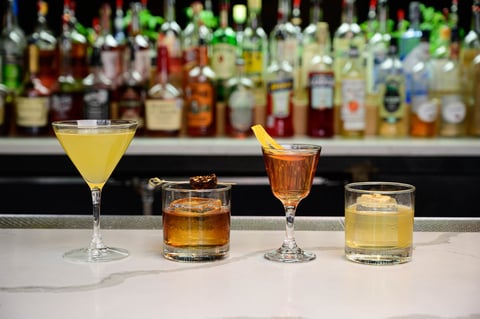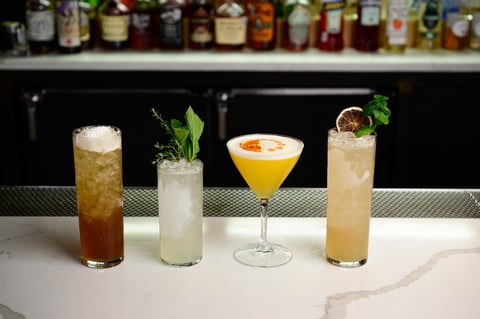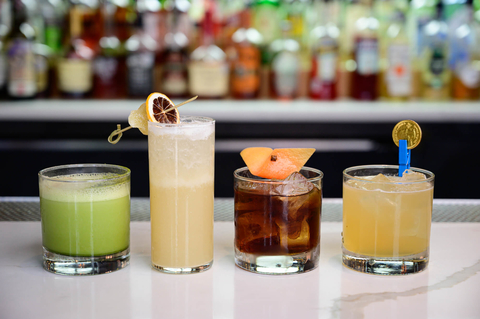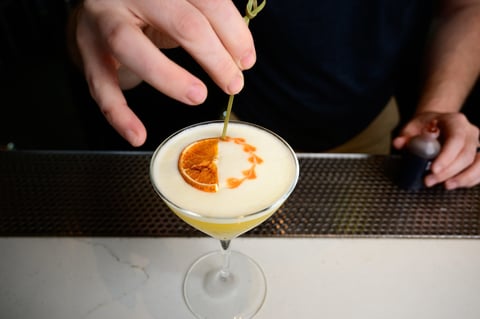There’s a fine line between refreshing a menu and alienating a portion of guests.
Parts one and two of this series on HIDE in Dallas addressed funding, partnerships, investors, opening doors, expansion, hiring, training and firing.
In this, the third and final installment, beverage director Scott Jenkins shares his knowledge, experience and approach to drink creation and cocktail menu development.
Menu Changes
At its core, HIDE is a hardcore drinks haven. Centrifuges, Perlini carbonating cocktail shakers, and other uncommon bar equipment shows Jenkins’ commitment to innovation. The bar is also fun and inviting, two keys to the success of any hospitality venue.
Jenkins has a brilliant mind for drinks, a major asset for a cocktail bar. But he’s also acutely aware that HIDE won’t succeed if he can’t speak to cocktail aficionados, casual imbibers, and drink neophytes.
Alienating guests for the sake of showing off with drinks would be bad for business. Such alienation can come in different forms: menus that are changed too often, too many choices, a lack of cocktails with familiar ingredients, and drinks that seem intimidating or pretentious to the average guest.
In its first year of operation, HIDE went through four or five menu changes that each had 30 to 40 drinks on them. So many drinks and menus made things “very difficult,” according to Jenkins. Guests and HIDE staff had only two or three months with each menu before they had to learn new drinks.
Jenkins did some retooling in HIDE’s second year. He rolled out just three menus and approached the differently. Each menu featured 20 signature HIDE drinks, eight to ten classics, and a handful of bottled cocktails.
Check this out: A Deep Dive into HIDE, Part One: Funding, Opening and Expansion
The menu’s layout and language has gone through a number of changes. In year one, cocktails fell under three categories: Carbonated, Shaken, and Stirred. In HIDE’s second year, Jenkins sought to communicate with guests with clear but compelling language that would be immediately understandable and relatable.
Signature drinks were listed under one of four main categories: Comforting, Refreshing, Strong, and Brave. Any guest could pick up the menu, read through the categories, and fully understand what to expect from the drinks in each one.
Looking for a drink that can comfort and relax you? Read through the selection under Comforting. Craving something refreshing? There’s an entire list of drinks that’ll quench your thirst. Interested in something spirit-forward? Strong has you covered. Feeling experimental and want to try something unexpected? Pick from Brave.
The four signature HIDE categories were tweaked slightly for year three (this year), with Spirited replacing Strong. Other drink categories are Classics, Bottled, Tapped & Frigid, Beer, and Wine. There’s also a brunch menu.

There were only two menus for 2019. Counting the menu that Jenkins and HIDE will release for the Miracle pop-up bar—HIDE was ranked number three for this international promotion last year—there will have been three cocktails menus by the end of 2019.
It’s important to note that Jenkins’ menus don’t change seasonally. In his opinion, seasonal menu changes limit the amount of time that guests have to try each drink. Many guests may never drink through an entire bar’s cocktail menu, but Jenkins feels it’s important to give them that opportunity.

Seasonal menus also require more rapid drink creation, which Jenkins admitted was challenging the first year HIDE was open. And, of course, more menu changes mean more team training, and that means increased labor costs. It’s likely, says Jenkins, that HIDE will launch only one menu in its fourth year.
Check this out: A Deep Dive into HIDE, Part Two: Learning, Hiring and Firing
That single menu change will give Jenkins and his team eight months to develop it fully. That timeframe used to be just four months. His changes have effectively doubled the amount of time he can experiment with drinks, equipment and processes.
“If you change your menu too often, people won’t have time to talk about it with others,” he says.
That lack of engagement and word-of-mouth marketing leads to a drop in guest experience quality. In Jenkins’ experience, it can take a single guest four times drinking a specific cocktail before they fully understand it, how they feel about it, and if they want to keep ordering it or try something else. Both these realizations have motivated Jenkins to reduce the number of menu changes.

Even reducing the number of annual drink menu changes to one is important, as far as Jenkins is concerned. It would be a mistake to never change a menu.
“People want to try different things, and team members want to make new things,” he says.
Operators need to adapt to changing consumer tastes and trends. They also need to study their peers and competitors and adopt and adapt the things that could work on their menus. Refusing to change menus can easily lead to being left behind by changing consumers and the competition.
Fully Understanding Costs
Jenkins is driven to create, to try and refine new cocktail build processes. And he’s also driven to learn from mistakes and better understand the business side of operating a bar.
To that end, some of the processes Jenkins seeks to refine are helpful for lowering costs. As beverage director, Jenkins runs a “very tight” pour cost, from 10 percent to 21 percent at the highest. Across the board, pour costs are between 12 to 18 percent. A “homerun” is what Jenkins refers to as a drink with very low cost that also sells incredibly well.
But to fully understand the cost of a drink, Jenkins says it’s crucial that operators understand the materials used, equipment, production, and training. When everything is factored into the cost of a drink, it’s possible for an operator to experiment with specialized approaches that have the potential to reduce costs.
Take, for instance, how deeply Jenkins understands the materials—spirits, mixers, modifiers—with which he works. He has studied specific spirits to learn their sugar content, known as brix. This allows him to be much more precise when adding mixers and modifiers.
That precision means that Jenkins can use less syrups and other sugary modifiers, meaning HIDE doesn’t go through them as quickly. Precision also leads to balanced cocktails, and balance is great for beverage businesses.
When guests drink balanced, precision-crafted cocktails they may not know why they taste better than similar drinks down the street, but they know they’re superior. Jenkins will explain to any guest who asks why HIDE’s drinks tastes better. That’s guest engagement.
Check this out: How Training Reduces Costs and Grows Revenue
The use of centrifuges is an example of how equipment and specialized processes can reduce costs. HIDE’s price tag—under $1 million and more than $500,000—included equipment uncommon to most bars. Guests won’t find them sitting behind the bar, but HIDE utilizes centrifuges, and they aren’t just fun to play with or cool to have. Specialized equipment allows HIDE to use less ingredients but make a bigger impact with their drinks, and using less ingredients reduces costs.
Working with Brands
Some operators seeking to reduce costs will strike deals sales reps, brands or distributors. Doing so, however, can sometimes lead to what seemed like a great deal turning into costly dead stock. Jenkins says that approach just doesn’t work for him or HIDE.
HIDE’s beverage director has built a reputation as a no-nonsense operator who doesn’t waste anyone’s time. Reps know they’ll get honest feedback about products they present to him, good and bad. Some reps don’t even bother approaching Jenkins with some products.
What’s effective for Jenkins, and therefore HIDE, is working with brands and products in which he believes. He wants to work with products he feels will make the best drinks for HIDE’s guests, and items he finds interesting.
Jenkins thinks operators should consider their identity and their brand’s identity when working with brands. In his opinion, it’s important to stay authentic and true to yourself and your concept when working with reps and brands.
Check this out: Brands Don't Owe You Anything
“You become like those you surround yourself with,” says Jenkins. “Make sure they’re the people and brands that align with you, your beliefs and your concept.”
Developing New Drinks & Menus
Materials, processes, and equipment leads to the team. Jenkins’ ego isn’t so big that he creates every single drink on HIDE’s menus. Any team member who wants to participate in drink and menu development is welcome to do so.
“Six palates are better than one,” says Jenkins.
Team members can come in on their days off to tinker and experiment with Jenkins. The goal is to nail down a new drink within four iterations. When the new drinks and menu are decided, Jenkins and the team train on it for four weeks.
Jenkins types up notes and processes for every drink on the menu. This includes the builds, tasting notes, garnishes, presentations, glassware…everything. Team members have an understanding of the equipment used to make HIDE’s drinks, which in turn gives them an understanding of drink costs. They’re included in the drink description drafting process to help them better sell the new cocktails to guests.
“People who don’t allow their staff to creatively engage are going to notice a large part of their culture is missing,” says Jenkins.
That creative engagement does have its limits. Team members are encouraged to help develop new menus, but there’s a time to be creative and a time to adhere to the current menu.
Jenkins doesn’t permit his bar team to make cocktails on the fly, and HIDE doesn’t do specials. HIDE bartenders are permitted to riff on the classics on the menu, but they’re not allowed to alter the signature drinks.
Check this out: Here's Why the Negroni Should be the Favorite Drink on Your Menu
Jenkins and the team members who choose to help develop new signature cocktails work very hard on those drinks, and they want the guests to try them. Rather than riff on signatures, the bar team is trained to engage with the guest, find out what they like, and make one or two suggestions from the current menu. That approach helps build relationships between bartenders and HIDE’s guests.
Below you’ll find one of HIDE’s newest drinks, Lucid Dreams. Whip a couple up, taste them with your bar team, and see if it gets any creative juices flowing.

Lucid Dreams
Recipe and image courtesy of HIDE in Dallas, TX
- 1.5 oz. El Dorado 3-Year Rum
- 0.25 oz. Giffard Passionfruit
- 2 bar spoons Giffard Vanilla de Madagascar
- 3/8 oz. Cinnamon bark syrup
- 0.75 oz. Acid-adjusted Mandarin
- 0.50 oz. Fresh orange juice
- 2 drops Orange flower water
- 3 drops 20% Saline
- 1 Egg white
- 1 to 2 drops of Angostura bitters to garnish
- Dehydrated orange half-wheel to garnish
Reverse-dry shake and strain into a chilled coupe. Garnish with drops of Angostura bitters and dehydrated orange (half wheel).
Resources
